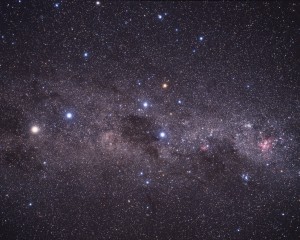Threaded through the partisan bickering during the debates on twitter last night was a string of tweets discussing ESO’s discovery of a planet in the Alpha Centauri system.[1] According to ESO’s press release, the planet was detected through the observation of “wobbles” in Alpha Centauri B’s path of motion. Astronomers speculated that the gravitational pull of an orbiting body was generating the irregularities. Putting the HARPS instrument on the 3.6-metre telescope at the La Silla Observatory to work on the problem, they discovered a planet with an orbital period of 3.2 days. The twitter is excited because Alpha Centauri B is a lot like our Sun and the newly discovered planet has the same mass as Earth—the theory being that our planetary twin has been discovered orbiting the star closest to our solar system. I’m not too worked up about the twinning possibilities, but I do think it’s cool that HARPS is doing exactly what it was supposed to do: find new planets.
In related news, I was intrigued by NASA’s response to ESO’s announcement. It’s as if they’re taking the discovery of the new planet a bit personally. Their press release, ostensibly a statement of congratulations to ESO on its accomplishment, reads more like an attempt to stake a claim on exoplanets of the universe. “We, too, have exoplanet finding capabilities! We have Hubble! We have Kepler! We have the James Webb Space Telescope!”
Click on the image to download wallpaper.
————————-
[1] Two stars comprise the Alpha Centauri system, Alpha Centauri A & B. They are indistinguishable to the naked eye, so we usually refer to them in the singular, as in “Alpha Centauri, the brightest star in the constellation Centaurus.”
